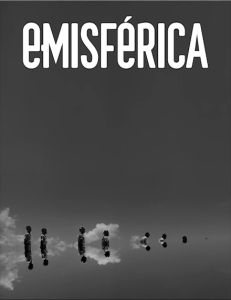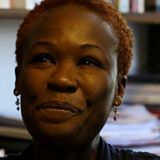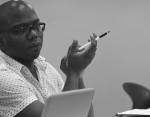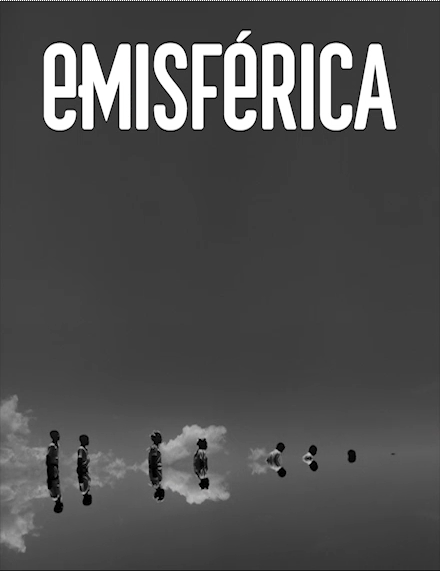This past summer marked the release of Caribbean Rasanblaj, a special double issue of the Hemispheric Institute’s journal, e-misférica. Our social media team at Anthropology Now was proud to spread the word about this unique online resource, which is available to all at: Hemispheric Institute’s journal, e-misférica
In this web-exclusive discussion for Anthropology Now, Andrea Queeley interviews the project’s creator, Gina Athena Ulysse. The interview is followed by a series of short commentaries on the rasanblaj by regional specialists.
Maria D. Vesperi, General Editor, Anthropology Now

Andrea Queeley: Why did you decide to edit this volume? What was your vision in bringing these pieces, people, images and ideas together?
Gina Athena Ulysse: I am on the executive board of NYU’s Hemispheric Institute for Performance and Politics. The permanent editors of e-misférica, the institute’s journal, asked me to consider guest editing following the amazing Decolonial Gesture issue edited by Macarena Barris-Gomez (USC). So moving to the Caribbean, as the ultimate site of decoloniality, was a natural progression. The conversation that ensued revealed we had common ideas so I decided to take on the project because e-misférica has been on the cutting edge as a multimedia platform/space that has consistently and boldly explored the complex intersections of performance and politics in the hemisphere. From the onset, my interest was expansive, focused on some of the thematics yet fully committed to curiously see what would emerge organically in the absence of a fixation to recreate geographies, lexicons and other modalities of empire.
AQ: In the call for papers, it seems that you envision Caribbean Rasanblaj to index a particular cosmology that is decidedly in opposition to linear models of knowledge production, history, time, human experience. Could you talk a bit about how the pieces in the issue exemplify and/or apply this cosmology? What has been your experience in making a place for this different kind of scholarship in the academy in general and anthropology in particular?
GU: The call in a sense began as a much-needed pause. Our impulse when confronting something new is often to decode, to make sense of it especially in terms of how it resembles what it is that we do know. I was quite conscious about the significance of considering rasanblaj on its own terms as a Haitian Kreyòl word with a cadence, contours, weight and meaning before jumping to translation. After having cast it out there as a way to express and think through the Caribbean, it became a matter of seeing who was inspired to respond and rise to the challenge posed by stretching themselves, playing with the concept and allowing themselves to explore spaces we had not even thought of as editors. The overall response was tremendous and quite broad, which is how we ended up with a double issue. We did receive quite a lot on Haiti but that wasn’t going to be our focus. Indeed, we were very concerned about representing the region and its diasporas and at the same time pushing the geographical boundaries, especially given that what binds us (those who had been colonized who are continually oppressed) transcends time and space.
So many of the pieces in the issue are key. The “Groundings on Rasanblaj with M. Jacqui Alexander” is a pillar that takes us to a different kind of foundation. Jacqui demands that we deal with questions of knowledge production, wholeness, integration and the limits and disciplining characteristics of fragmented institutions. Jacqui is at a point where she’s talking about healing explicitly. What does it mean to come to this work cerebrally? The thing that is missing, for her, is Spirit. I knew she would be bringing that in. Sibylle Fischer revisits Locke’s writing at the beginning of the #BlackLivesMatter movement, a time when issues of blackness and freedom seem so antithetical. Ana Lara and Josefina Baez, both from the Dominican Republic, engage in a conversation that defies and redefines spaces of open engagement, bringing that readers to their crossroads in a sense and keeping them there as they speak to each other with us looking in, listening, voyeurs. The concern is cultivating an integrity in practice of conversations we do have when the concern is not about the audience. Similarly, Larry La Fountain Stokes’s piece on Freddie Mercado’s ultrabaroque rasanblaj and Antonio Ponte’s piece on the cooking show in 1950s Cuba, as well Yanic Hume’s piece on the shifting from Rara to Gagá and Sheller’s reading of Tavares Strachan and the amazing dossier line up as well as these three major multimedios contributed and expanded the dimensions of this rasanblaj. There are more commonalities among what we were able to gather. I remember interviewing Alex Kingston of Idle No More a year prior and when she spoke of the round dance that is characteristic of their protests in Canada, I thought, “Oh that’s a rasanblaj.” The land-based philosophy that inspires this movement and Misty DeBerry’s incantation of Little Sister has so many other resonances… I could keep going.
In response to the second part of the question, I’d say things were tougher when my understanding was less sophisticated. Anthropology is what it is and always will be. There are so many different sections, so many journals and audiences. Sure, we may claim Zora Neale Hurston, Katherine Dunham and Pearl Primus and others as our pioneers, but there are profound “disciplinary” anxieties around (and punishments reserved especially for) black women as knowledge producers who insist on troubling epistemological boundaries. Part of the point of getting a doctorate is to increase the overall value of this fictive objectivity, which the artist in so many instances rejects. There is a lot of investment in keeping these polarized. The limits and resistance to transgressions are so deeply fermented.
There are many professional, political and always personal reasons for this. Change is a process and very slow. I became most productive and fulfilled once I altered my relationship to why I do the work I do. I learned from people whose work has influenced and inspired me to focus on and engage with my interlocutors as a most effective approach. What has driven me since I was a grad student is not security or tenure but a bigger existential question about making meaning in an unjust world. I am not and have never wanted to be the only one, or to have a seat at the table. I have always responded to an internal call and hopefully contribute something to society.
AQ: How do the concepts of rupture/suture, dislocation/emplacement, dispersal/gathering, and dismemberment/remembrance get turned around and over in your work and the work of those featured in this issue? To what end?
GU: Working towards creating a space where the above concepts could be explored was very central to this project. An obvious example of this is Sinclair Tompson’s piece, which deals with ritualizing the symbolic reassembly of the dismembered body of indigenous Bolivian revolutionary Tupac Katari. Carolyn Cooper’s performative critique professing slackness disrupts the linguistic hegemony of English, forcing us to reconsider questions of authority with Patois. Mario Lamothe’s take on Dedouble as an embodied dance form, social practice and theoretical frame for queer positionality in Haiti; Carlos Decena’s body portal fantasy… imagining realities spaces.
AQ: In looking through the issue, I was reminded of the Mende proverb “You know who a person really is by the language they cry in” which lead to title of the 1998 documentary “The Language You Cry In” that chronicles the connections between a group of Mende in Sierra Leone and Gullah people in Georgia through a graveside ceremony dirge turned children’s nursery rhyme. Could you talk a bit about language, history, and memory as it relates to Rasanblaj/rasanblaj, violence, and the colonial/post-colonial Caribbean?
GU: The etymology of the word is infused with a colonial history and memory of the region. This is one reason the call for participation referenced an article in the Code Noir. It was so significant to recall that our very existence and presence in this so-called New World was bound by legal measures and restrictions. Violence marked the conditions of our crossing.
AQ: Well, is there a way that the work in the issue has liberatory potential or does the healing work necessary for liberation? What do you see as our role as scholars, researchers, activists, and artists in addressing/redressing the mark of legally and extra-legally sanctioned violence?
GU: I think the first part is that I don’t think of any of us as a collective. There is no “we” per se and I’ll explain. The reason I reject a collective “our” is that you and I may want to think of ourselves a “we” but not everyone does, nor wants to and or should. I’m not at all moved to force anything on anyone. When I did the call I was curious and wanted to see who was going to be bold, who was going to courageously cross over the line. I think my role is to create the space for transgression. That is why I began the call for papers the way that I did…why I consciously went against the grain. It was an invitation meant to inspire exploration. What I want to get to is how this may have started out as a call to individuals, but by the way people responded they created a collective space. In a rasanblaj not everything is equal, it’s bits and pieces. Some are massive and some are the size of an ant but the important thing is the engagement, the intention. I didn’t expect a collective but it materialized.
AQ: Talk to me about Jeannette Ehlers’ “Black Bullet” and why you chose to have that image be so prominent in this issue.
GU: Credit should be given first to Marcial Godoy –Anativa who has co-edited the journal with Jill Lane for the last ten years. Both are at NYU. Marcial has a super keen eye that resonates with the readership. When he mentioned it, I was on board because I really appreciate Ehlers‘s work, which was brought to my attention by Arlene Torres several years ago. I really loved this particular piece as it is so full of significations. The footage was shot in Haiti at the Citadelle Laferrière and Ehlers has spoken of interest in the Haitian Revolution, which inspired a series of her works. Did I think about what it would mean to have the work of an artist based in Europe on the cover of a compilation about the Caribbean and its diasporas? Yes, I did. But that obviously wasn’t a deterrent. From the onset, so much of this project was about rethinking, remapping, reconfiguring, reordering and disordering. It made sense to me that in these times, when both the words black and bullet are so loaded, rasanblaj could and would rotate us to another point of departure. Ironically Haiti—First Black Republic—leads us into the issue yet we covered as much of the Caribbean as we could gather. I was most thrilled with the commitment to make this e-misférica’s very first animated cover, which is so in line with the movement inherent in the concept and practice of rasanblaj. I am also most appreciative of the Hemi team (Kerry Whigman, Dexter Miranda and others) as this was a tremendous effort that to create.
AQ: How do you envision linking texts and the performative, both practically and conceptually?
GU: My methodology depends on the actual topic and form of the work. I think the works featured in the issue are quite telling of differences in possibilities of forms. For example, in his project Fractal Engagements (1) Charles Campbell provided a performance and journey through Downtown Kingston.
AQ: Undisciplining disciplines and colonial boundary-crossing seem to be central to your project as a scholar and artist. What was the genesis of this mission/vision? Where do you plan to direct it next?
GU: If there a specific point to the origin story of my work/practice, it’s definitely the academy. It was graduate school eons ago as I was working on the doctorate for anthropology. I was being trained to become this disembodied subject. My spirit was under siege and would not/did not take to it because I was an artist first and I did not want to trade that part of myself for a shiny new model. I was not willing to eschew that aspect of myself to become cerebral, respectable et cetera while confronting what Catherine Lutz calls the “gender of theory” and Hayden White’s “the content of the form.” I was fortunate to be exposed to Faye Harrison’s and ABA’s call to “decolonize anthropology” while “writing in my father’s name” as Ruth Behar had done. So I didn’t start out with a mission or a vision, I was simply trying to protect and not let limited and toxic institutions break my spirit, for which I have paid a very high price. I’m not at all gullible and I do know exactly where I am (academia). A favorite quote from Alexander’s piece says it all. She wrote, “we cannot continue to live fragmented lives—of the kind that was generated as part of that earlier colonization and slavery—yet hope to create holistic institutions. It just cannot happen.” Informed by feminist standpoints, my work has evolved over the years and is less reactionary understanding my relationship to these fragments. It’s organic and comes from a deep place of communion. I take great pleasure in it even though I am lured to get deeper into the most horrific parts of our past.
With my recent promotion to full professor, I have more time and absolutely no pressure. I am in a good professional space now. When asked to participate in conferences and so on, folks know that more than likely, I will want to perform. I am working on multiple things simultaneously. VooDooDoll is a lifetime project that I am in no rush with and there is a new piece I started this spring, “Contemplating Absences and Distances,” which I presented at the “Spaces, Scales and Routes” symposium held at Harvard this past May. Its foundational text is a précis on the 18th century grain crisis in Saint-Domingue (from the Colony in Crisis project) interwoven with actual listings of items exchanges for Africans to be enslaved … this intersects with my interest in food and gatherings. Lately, I have been taking my own photography work more seriously and been writing on #BlackLivesMatter; as our black bodies are under siege, I cannot keep silent. I have also been having these private conversations with André Breton for way too long now that really need to be made public. Of course, this e-misférica issue was a first of many rasanblaj… I always go where my muses lure me.
(1) http://hemisphericinstitute.org/hemi/en/emisferica-121-caribbean-rasanblaj/campbell

A professor of anthropology at Wesleyan University, Gina Athena Ulysse is the recipient of the 2015 Haitian Studies Association Excellence in Scholarship Award. She is also a poet, performance artist and multi-media artist. She is author of Downtown Ladies: Informal Commercial Importers, A Haitian Anthropologist and Self-Making in Jamaica (Chicago 2008) and the bi-lingual collection of post-quake dispatches, essays and meditations, Why Haiti Needs New Narratives: A Post-Quake Chronicle (Wesleyan 2015). She continues to develop VooDooDoll, What if Haiti Were a Woman, a performance-installation project. Ulysse is a member of the Anthropology Now Editorial Board. Her recent writing has appeared in the journals Gastronomica, Souls, Transition and Anthropology Now. She is a regular contributor to the Huffington Post.
 Born and raised in Berkeley, California, Andrea Queeley is a cultural anthropologist who seeks to expand and deepen critical understandings of the global Black experience with a geographic focus on the Americas. Her work contributes to a broader and interdisciplinary inquiry into how racialized subjects negotiate structural inequalities in contexts of political, economic, social, and environmental crisis. She currently lives in Miami, Florida and teaches at Florida International University, where she is associate professor of Anthropology and African and African Diaspora Studies.
Born and raised in Berkeley, California, Andrea Queeley is a cultural anthropologist who seeks to expand and deepen critical understandings of the global Black experience with a geographic focus on the Americas. Her work contributes to a broader and interdisciplinary inquiry into how racialized subjects negotiate structural inequalities in contexts of political, economic, social, and environmental crisis. She currently lives in Miami, Florida and teaches at Florida International University, where she is associate professor of Anthropology and African and African Diaspora Studies.
An Invitation to Voice
by Patricia Mohammed
The introduction to Rasanblaj provides a challenge to “resist the impulse to translate,” “think consciously of the sound” and “play with its contours.” {{link}}This carte blanche invitation to freedom from the usual constraints required by academic journals is particularly inviting to Caribbean-based creative thinkers. It opens up the terrain for expressing knowledge and representing experience in the many different voices that constitute the Caribbean. What is that voice and why is there such a need for this multi-colored, diversely formatted set of narratives to surface in Anthropology Now?
I recently attended a fiction writing course in the United Kingdom and found myself the only non-white, non-British person, among a group of near 20. The writing exercises that required one to summon up memory and feeling immediately established that history, geography, climate, clothing, flora, fauna, language and taste erect distinctive boundaries despite global travel and communication. The difference in my voice was never more apparent, but, interestingly, not in a diminished way. I found having a uniqueness of tone and the capacity to combine many worlds effortlessly to be extremely liberating. It resembled in some ways the fluency of switching language without a pause for breath. My storied memory took me to a village childhood in Trinidad in the 1950s, to young adulthood in Brighton, Sussex, in 1984 and the night of the Grand Hotel IRA bombing that Margaret Thatcher survived, to the tragedy of my Jamaican helper in the 1990s whose daughter’s budding sexuality was commissioned by the dons of the village, then back to a tale of my gardener in the tropical forested Maracas Valley, Trinidad, where my house stands. Now deceased, John had worked on the cocoa estate that predated the modern suburban housing occupying so much of our landscape. He had seen the valley change from a pristine wooded paradise to its present-day hillside settlements that eat away at the foundations of the protective mountains. Each of these stories is variegated by linguistic, philosophical and political references and expressions that blend and collide, proving the contemporaneousness that the Caribbean possessed before its time.
It is not this capacity to absorb and express a speckled difference that convinces me of a Caribbean uniqueness. All societies have their specialness that must be recognized and appreciated. Perhaps it’s the project of growing more confidently into our skins as time progresses, with pictures and sound and language and an unapologetic laughter at ourselves. Perhaps it is the willingness to accept the Caribbean as differentiated within, that voices such as my own (of Asian descent) are not drowned out by others more demographically present because mine resonates with a different timbre. The Caribbean is a relatively young ‘new world’, comprised of older cultures that were thrown together, still grappling with their metaphors and mythologies, out of which it might build a future that will withstand the onslaught of other, far more dominant cultural imperialisms still to come. What Rasanblaj provides is a critical space of nonconformity to engage and expand the ongoing conversation that has occupied many writers and artists. This desire to have a contextual grasp of its ontology is fundamental in the Caribbean process of growth and evolution. It echoes the understanding of older states that appear more knowing about the philosophies by which they live and the generative mythologies on which they build nationhood. Rasanblaj is timely and well-named, a site for spirited and innovative souls to create new embers of thought.
 Patricia Mohammed is a scholar, writer and filmmaker. Her main areas of interest are gender studies, history, film and art. She is currently professor of Gender and Cultural Studies and Head at the Institute for Gender and Development Studies, University of the West Indies, Trinidad. She is a pioneer in second wave feminism and the development of gender studies in the Caribbean and has published widely in these areas for over three decades, more recently adding cultural studies to a gendered lens in her work. Her academic publications include Imaging the Caribbean: Culture and Visual Translation (2009), Gendered Realities: Essays in Caribbean Feminist Thought ( 2002), an edited volume, and Gender Negotiations among Indians in Trinidad, 1917–1947 (2001), along with numerous essays in journals, books, magazines and newspapers. She has completed some 13 documentary films, among them Engendering Change: Caribbean Configurations and a seven-part series, A Different Imagination which includes the award-winning “Coolie Pink and Green.”
Patricia Mohammed is a scholar, writer and filmmaker. Her main areas of interest are gender studies, history, film and art. She is currently professor of Gender and Cultural Studies and Head at the Institute for Gender and Development Studies, University of the West Indies, Trinidad. She is a pioneer in second wave feminism and the development of gender studies in the Caribbean and has published widely in these areas for over three decades, more recently adding cultural studies to a gendered lens in her work. Her academic publications include Imaging the Caribbean: Culture and Visual Translation (2009), Gendered Realities: Essays in Caribbean Feminist Thought ( 2002), an edited volume, and Gender Negotiations among Indians in Trinidad, 1917–1947 (2001), along with numerous essays in journals, books, magazines and newspapers. She has completed some 13 documentary films, among them Engendering Change: Caribbean Configurations and a seven-part series, A Different Imagination which includes the award-winning “Coolie Pink and Green.”
Poppy Show: the Mythologies of Progress in Jamaican Life
by Rich Blint
August is the month of independence and emancipation celebrations in Jamaica. It might seem futile, rude or foolishly beside the point these many decades after the struggle for decolonization, but one is still pressed to ask what it means for formerly enslaved and colonized Jamaicans to celebrate the anniversary of emancipation from slavery and independence from Britain when the reality of their present-day relationship to global economic and political arrangements remains deeply asymmetrical—to put a dangerous and persistent problem rather nicely. One can go further and inquire what significance such expressions of liberty hold for citizens in the context of the troubling psychic and material emergencies confronting the region—from the mass expulsions of Haitians in the Dominican Republic to an already besieged nation; the unprecedented debt crisis of Puerto Rico, that neglected, American colony; and the everyday ravages of structural adjustment and austerity regimes that continue to maintain a stranglehold on local economies, formal and otherwise. In the middle of all this comes the announcement of Pride JA, a march scheduled for later this month and organized by JFLAG (Jamaican Forum for Lesbian, All Sexuals, and Gays) under the theme of “The Pride of a People: Breaking the Rules of Oppression.” JFLAG must be lauded for incredible work over the years in bringing light to the persecution of a population of people my Caribbean colleagues crudely refer to as “sexual minorities.” But questions linger as to the wisdom of rehearsing the Western (and now globally corporatized) model of parades and marches as a signal of one’s pride and as an attempt to “break the rules of oppression” when popular opinion is so strongly against the repeal of the country’s draconian sodomy laws. This institutionalized declaration of the “previously” beleaguered and menaced announcing their presence in a national narrative of reform represents an act of defiance on the one hand, and a moment of political theater on the other. Put simply, instead of a call for difficult and sustained dialogue about an almost intractable subject, a surrogate is made available to stand-in for more messy and dissenting opinions concerning sexuality and patriarchy.
Interrupting these ritualized choreographies in the theater of post-colonial freedom with its grand narratives recounting a history of resistance to revolution strikes me as particularly important right now, not only given the profound challenges stunting the Caribbean, but also in light of the related crises of migration in Africa, the rise of fundamentalism, East and West, financial disorientation in Europe and the lethal use of state power in the United States.
Caribbean rasanblaj, in its effort to re-assemble, re-member, and re-gather the fragmented, dislocated, and fractured history of the Caribbean, represents a refusal of surface level declarations of progress. If, as M. Jacqui Alexander suggests, that a “Spirit of re-assembly is already at work,” then it seems logical that it would demand not gestures of staged reform that run counter to the circumstances on the ground, but that “we” be called upon “to behave differently, to form this new moment…[as a practice]…a way of being.” As Jamaicans mark the anniversaries of necessary and important struggle, the refusal of thin and brittle notions of progress that nibble at the edges of transformation seems reasonable. If “how we align ourselves with our destiny” is, indeed, the “fundamental charge of rasanblaj,” then one must, as James Baldwin reminds us, actively work against the “legends, myths, and coercion” within which society is bound and instead court that void of self-making Baldwin covets, a void that requires “new act[s] of creation, which can save us from all the evil that is in this world.” This difficult, necessary, and practiced activity represents the ethos and challenge of Caribban rasanblaj, which involves a complete overhaul and re-making of a world appropriate for fulsome and ultimately divine habituation. Such labor might ultimately beg the lie of what is now famously referred to as the “non-event” or, as I like to call it, the forced-ripeness of emancipation.
 Rich Blint is associate director of Columbia University School of the Arts Office of Community Outreach and Education and research affiliate and adjunct assistant professor in the Institute for Research in African American Studies at Columbia. He is co-editor (with Douglas Field) of a special issue of African American Review on James Baldwin (Winter 2013); contributing editor of The James Baldwin Review; curator and co-curator, respectively, of the exhibitions The First Sweet Music (2014) and Bigger Than Shadows (2012, with Ian Cofre)). He is also curator of the exhibition series built environments at Columbia, an initiative conceived to engage contemporary issues in fine art concerning aesthetics, value, difference, and public space. Rich earned his doctorate in the Program in American Studies at NYU and is currently at work on his book project, Trembling on the Edge of Confession: James Baldwin and Racial Iconicity in Modern American Culture. He sits on the boards of Vanderbilt University’s Issues in Critical Investigation: The African Diaspora, and CLAGS: The Center for LGBQT Studies at the Graduate and University Center, CUNY.
Rich Blint is associate director of Columbia University School of the Arts Office of Community Outreach and Education and research affiliate and adjunct assistant professor in the Institute for Research in African American Studies at Columbia. He is co-editor (with Douglas Field) of a special issue of African American Review on James Baldwin (Winter 2013); contributing editor of The James Baldwin Review; curator and co-curator, respectively, of the exhibitions The First Sweet Music (2014) and Bigger Than Shadows (2012, with Ian Cofre)). He is also curator of the exhibition series built environments at Columbia, an initiative conceived to engage contemporary issues in fine art concerning aesthetics, value, difference, and public space. Rich earned his doctorate in the Program in American Studies at NYU and is currently at work on his book project, Trembling on the Edge of Confession: James Baldwin and Racial Iconicity in Modern American Culture. He sits on the boards of Vanderbilt University’s Issues in Critical Investigation: The African Diaspora, and CLAGS: The Center for LGBQT Studies at the Graduate and University Center, CUNY.
RASANBLAJ and its Discomforts
by Myron M. Beasley
“Resist the impulse to translate, pronounce it first. Think consciously of the sound. Let the arch of the r roll over the ah that automatically depresses the tongue…” Gina Ulysse opens the special issue of E-MISFÉRICA with these poetic, instructive words. The lyrical performance reminds me of the undergraduate courses in oral interpretation that introduced me to the refrain, literature was not just written to be read, but written to be heard. Ulysse’s small statement introduces the promissory lens of performance, which holds the power to nudge, change, transform the unspoken to the spoken, the passive to the active. The utterance of the tongue, the power of the plosive sounds against the teeth and lips, Ulysses invites readers to RASANBLAJ. The term, like the word performance has meanings just as diverse in scope, yet at its core the definition holds suggestions to do, to act, to provoke. RASANBLAJ
“cocophanic routes/…moving beyond somatic liberation.” (Ulysse)
Upon hearing that I would be “doing field work” in Haiti, a co-researcher replied, “The only way to possibly understand Haiti is to bundle all of what you consider logical or what you’ve learned in the U.S. place it in a bottle, shake it up, then throw it out the door.” This special issue is a bundling, a shaking, and a tossing out to sea of traditional Western (mostly) ways of seeing and knowing. It’s the turning things upside down—I mean down to the root level—then and only then might one get a flitter, a grasp, of the disparaging systematic structures of colonialism.
In “Atlantic Ontologies,” Sibylle Fischer contemplates the repetition of grieving and mourning the dead in comparison to a method of inquiry among Afro-descendent communities in the Caribbean. The repetition is at its core the replaying of violence against the repeated (romanticized) narrative of freedom. The interrogation of the political theories of John Locke (and others in the West) is found fallacious in the study of the everyday realities and the art of the Grand Rue artists who reside in a junkyard in the center of Port-au-Prince. The Grand Rue sculptures for Fischer are performative acts of resistance that represent both the dismantling of traditional ways of knowing/seeing and re-imagining of a different reality and future. “Rasanblaj has only one standard: Does it work?” (Fischer)
“We do not need a verb to validate our existence” (Ulysse)
The gender-bending/queer/drag—well, the performance of Freddie Mercado fascinates and disturbs because it refuses a label or category–never fitting neatly into one specific box. The grotesque living sculpture or maybe a life-size trans-puppet donned with gender specific garments splattered with images on the body occupying spaces on the island of Puerto Rico. La Fountain-Stokes considers Rasanblaj as a move “to engage with the multiplicity and complexity of the Caribbean not in an effort to move away from it, but rather to dirty metropolitan models: to make them engage the radical, communitarian, erotic, decolonial, utopian, profoundly historical present and future of the region.” Mercardo’s performances undergird that gender and race are just as fluid as the waters of the Caribbean. I like the concept of messy to describe the work of Mercado. Messy, not to connote disarray, but rather a powerful position of possibilities and the range of gender identities that disrupt a binary—or should I say the (lingering) pervasive model of gender performance. Mercado’s performances also chisel at the roots of internalized racism by disturbing the topics of skin-tone, hair texture and body shapes to play against “the model” of beauty and a standard imposed by others.
“undoing enlightened reason” (Ulysse)
The special issue of E-MISFÉRICA on the topic of RASANBLAJ is a challenge, an invitation to disrupt and perform ruptures that reveal disparaging oppressive flows that demand action. RASANBLAJ is becoming uncomfortable.
 Myron M. Beasley is associate professor in the areas of Cultural Studies, African American Studies and Women and Gender studies at Bates College. His ethnographic research includes exploring the intersection of cultural politics, material culture and social change. He has been awarded fellowships and grants by the Andy Warhol Foundation, the Whiting Foundation, the Mellon Foundation, National Endowment for the Humanities and most recently, the Ruth Landes Award from the Reed Foundation. His ethnographic writing about Africana Cultural Politics, Contemporary Art, Gastronomica and cultural engagement has appeared in many academic journals including Text and Performance Quarterly, Gastronomica: The Journal of Food and Culture, The Journal of Poverty, Museum & Social Issues, The Journal of Curatorial Studies, Food and Foodways and Performance Research.
Myron M. Beasley is associate professor in the areas of Cultural Studies, African American Studies and Women and Gender studies at Bates College. His ethnographic research includes exploring the intersection of cultural politics, material culture and social change. He has been awarded fellowships and grants by the Andy Warhol Foundation, the Whiting Foundation, the Mellon Foundation, National Endowment for the Humanities and most recently, the Ruth Landes Award from the Reed Foundation. His ethnographic writing about Africana Cultural Politics, Contemporary Art, Gastronomica and cultural engagement has appeared in many academic journals including Text and Performance Quarterly, Gastronomica: The Journal of Food and Culture, The Journal of Poverty, Museum & Social Issues, The Journal of Curatorial Studies, Food and Foodways and Performance Research.
The Caribbean Rasanblaj As a New Cartography
by Laurent Dubois
What a gathering of reflections, incitements, and invitations! The Caribbean Rasanblaj curated by Gina Athena Ulysse offers us a rich set of reflections, in a variety of forms, suited to the sedimented and multi-vocal reality of the region. It also represents a model for how to present excellent scholarly and theoretical analysis in digital format. Easily navigable, spare and precise in design, and woven together thoughtfully, the issue constitutes a space in which readers can dwell, wander, stop and think.
Caribbean art and performances are at the center of the collection, but they also animate its aesthetics and approach, allowing for different frames and forms of reflection. Analysis happens here on many different levels, through guidance and parsing of cultural forms and practices but also through affect and aesthetics, a combination that is a spur for us to be adventurous and imaginative about thinking the Caribbean.
This is a cartography of sorts, but it is a map that belies the usual conceit of maps, for it is open-ended in its symbolism, ever-conscious that two dimensions cannot account for the depths, indeed offering us the possibility that we don’t yet even know all the dimensions of experience and history, sound and vision, that we might ultimately encounter, out of searching and out of necessity, in grappling with the Caribbean. I am grateful for this set of invitations, the model and challenge posed here, opening the way forward.
Laurent Dubois is the Director of the Forum for Scholars & Publics at Duke University.


